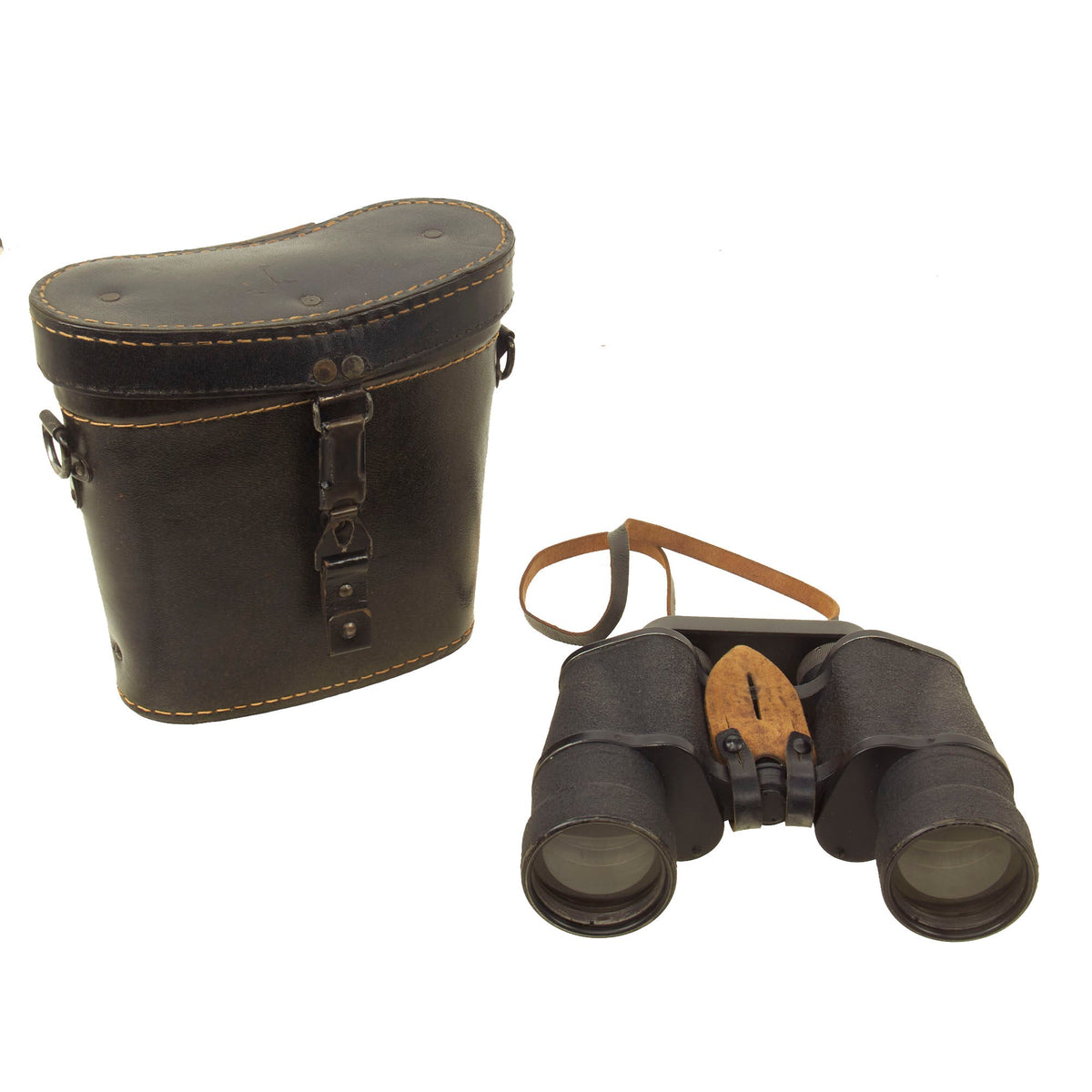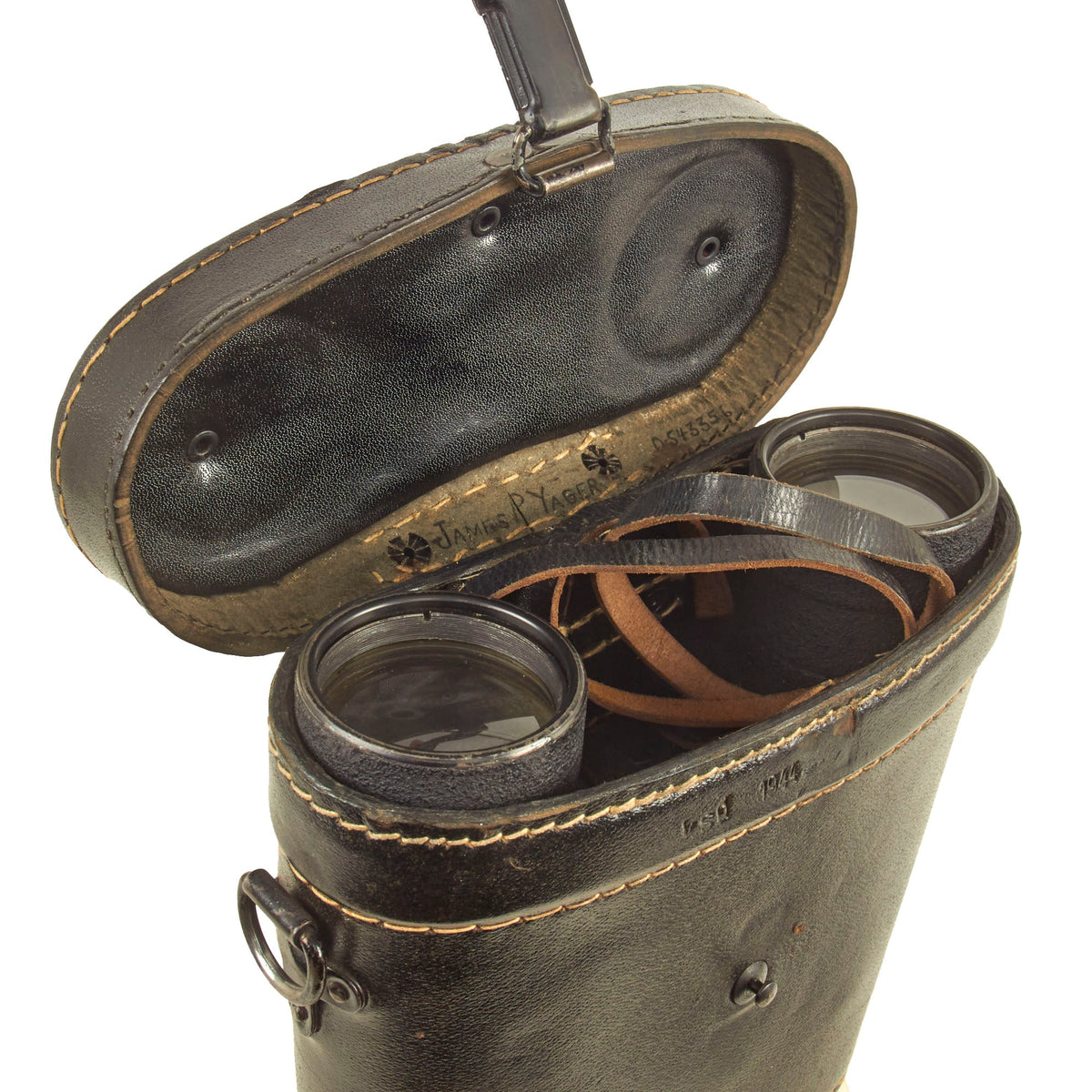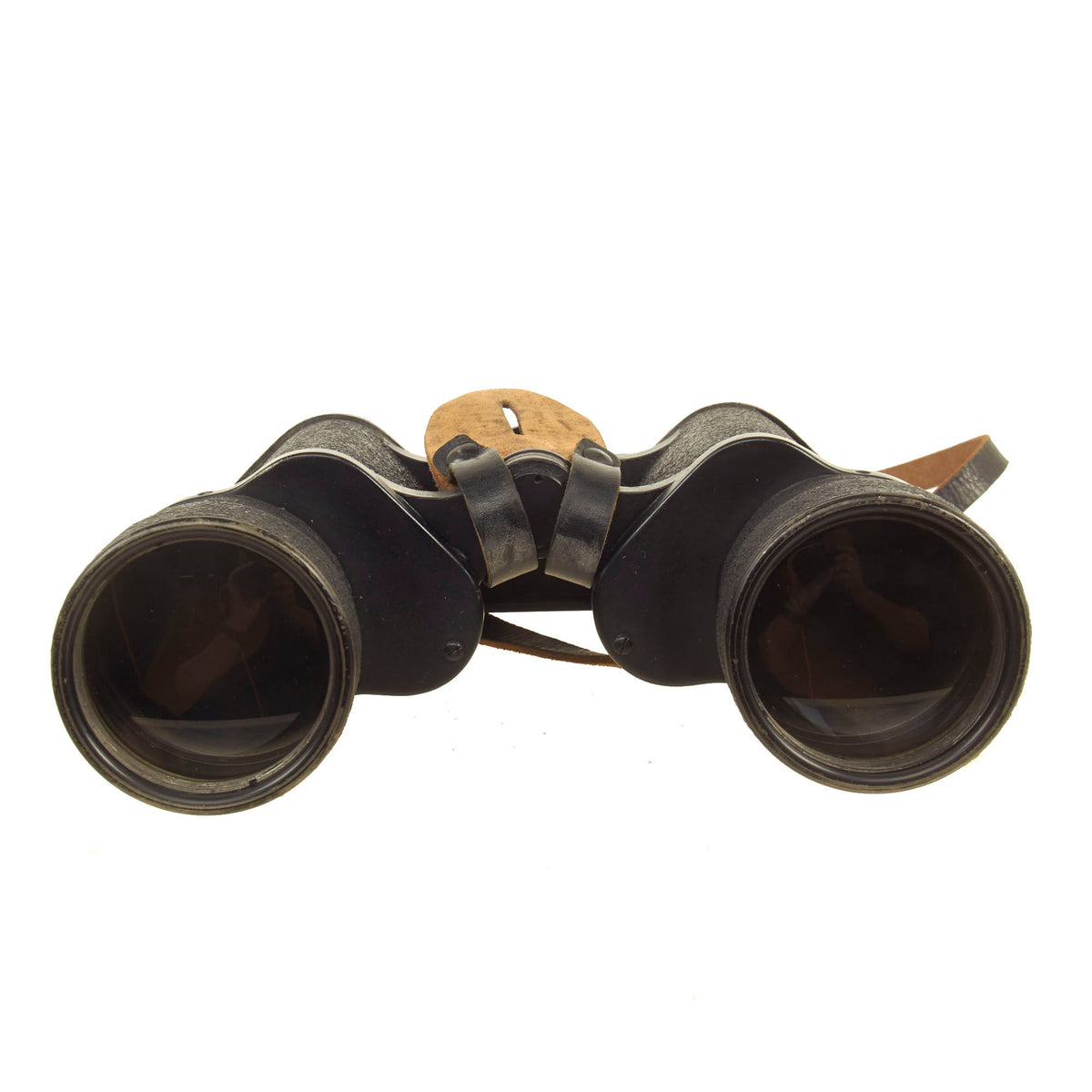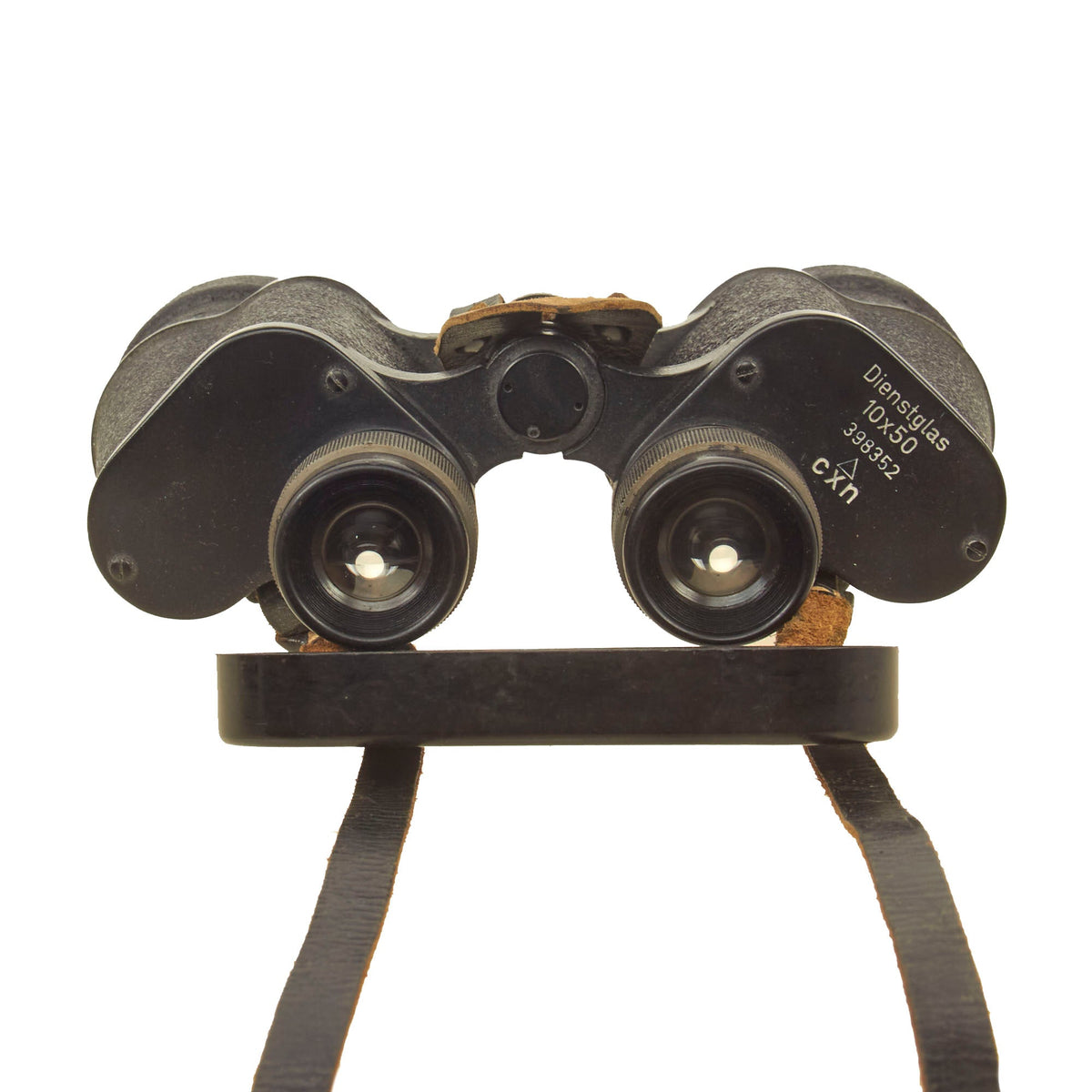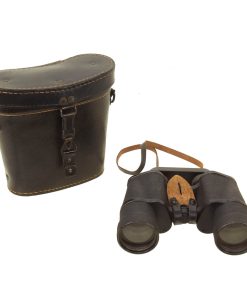Original German WWII 10×50 Dienstglas Binoculars by Gustav Appel, Berlin-Spandau with Leather Case dated 1944 – Brought Back By Army Chaplain Lt. Colonel James Jager, 406th Field Artillery Original Items
$ 995,00 $ 248,75
Original Item: Only One Available. The 10 x 50 Dienstglas was one of the most used German issued binoculars of WWII. These are fully functional with clear optics and made by one of the very best makers at the time (still in business today!). They are nicely marked as follows:
Dienstglas
10×50
398352
cxn
The left barrel is maker marked for Gustav Appel, Berlin-Spandau and comes complete with original black leather carry strap. Both diopter adjustments operate smoothly and there are no chips or dings on the eye cups. There is wear to the textured coating, mostly on the right side, indicating that the soldier probably held it one-handed. The optics are in excellent condition and clear. Original leather neck strap is included, and is in great shape, still soft with most of the finish remaining.
Also included is the excellent black leather carry case with working spring loaded closure strap. The case is in excellent condition, without a carry strap. The case is dated, maker marked, and Waffenampt proofed on the lip of the lower portion: ksd 1944.
The inside lip is marked with James P. Yager O-543356. James Yager was a US Army Chaplain, having been Ordained on June 7, 1941 after attending seminary at Mount Saint Mary’s in Norwood, Hamilton, Ohio. During WWII he served as a Chaplain for the 406th Field Artillery Group. After the war he continued service with the Michigan National Guard until 1966. After this, he reentered service with the Army and served as Chaplain in both Nuremberg and Berlin. He retired from the military in 1970 after approximately 30 years of service, reaching the rank of Lieutenant Colonel. Following military retirement he served as a priest in St. Mary’s Church of Spring Lake, St. Mary’s Church of Sand Lake and St. Clara’s of Coral, St. Mary’s of Spring Lake again, Our Lady of Fatima of Shelby and Rothbury and finally St. Catherine’s of Ravenna, to which he was named Diocesan Consultor. In October 1980 Father Yager was honored with the Distinguished Service Award for demonstrating the highest level of dedication and contribution to Catholic Secondary education over a period of many years.
This is overall an excellent example of the classic eye piece for German infantry officers during WW2 which continued service with a US Army Chaplain!
Models
Binoculars used by the German military in the Second World War were made by a huge number of makers. The most well-known were Carl Zeiss, Ernst Leitz, Swarovski and Voightlander. Up to 1940 they carried the maker’s name and as well as the word ‘Dienstglas’which means service glass. From around 1940 the the maker’s name was replaced by a three letter code.
There were three common types of binocular issued to the German military before and during the Second World War: 6×30, 7×50, 10×50.
6×30
The 6×30 was the type commonly issued to NCO and officers. According to ‘Deutsche Soldaten’ they were issued to the squad leader independent of rank. They often had a graticule which is a series of lines in the right-hand lens. It was used to estimate distances. If you knew the size of a man or a truck that you could see with the binoculars, you could estimate the distance based on the number of lines it measured in the graticule. It was a technique that soldiers had to learn.
Early binoculars were made from brass. Later ones were made from an alloy of magnesium and aluminum, which was extremely light. Towards the end of the War binoculars were sometimes made from bakelite.
7×50
These are the classic night vision binoculars preferred by sailors. However, this spec was also used by the Wehrmacht (Army) and Luftwaffe (Air Force) as well as the Kriegsmarine (Navy). They are larger and usually the classic Zeiss shape.
10×50
These are the most practical size for modern applications such as bird watching or spectator sport. They give you powerful magnification and bright lenses. They had specialized use in wartime and were issued to artillery units. Senior officers have also used this type of binocular.
Field Marshal Erwin Rommel, the Desert Fox, used a pair of 10×50 Dienstglas binoculars. His had the bakelite eyepiece caps missing. He more than likely had them removed to better fit his “trademarked” dust goggles.
Fast Shipping with Professional Packaging
Thanks to our longstanding association with UPS FedEx DHL, and other major international carriers, we are able to provide a range of shipping options. Our warehouse staff is expertly trained and will wrap your products according to our exact and precise specifications. Prior to shipping, your goods will be thoroughly examined and securely secured. We ship to thousands clients each day across multiple countries. This shows how we're dedicated to be the largest retailer on the internet. Warehouses and distribution centres can be located throughout Europe as well as the USA.
Note: Orders with more than one item will be assigned a processing date depending on the item.
Before shipping before shipping, we'll conduct a thorough inspection of the items you have ordered. Today, the majority of orders will be delivered within 48 hours. The delivery time will be between 3-7 days.
Returns
The stock is dynamic and we cannot completely manage it because multiple stakeholders are involved, including our factory and warehouse. So the actual stock may alter at any time. It's possible that you may not receive your order once the order has been made.
Our policy is valid for a period of 30 days. If you don't receive the product within 30 days, we are not able to issue a refund or an exchange.
You can only return an item if it is unused and in the same state as the day you received it. You must have the item in its original packaging.
Related products
Uncategorized
Band of Brothers ORIGINAL GERMAN WWII Le. F.H. 18 10.5cm ARTILLERY PIECE Original Items
Uncategorized
Uncategorized
Uncategorized
Uncategorized
Uncategorized
Uncategorized
Uncategorized
Uncategorized
Uncategorized
Uncategorized
Uncategorized
Uncategorized
Uncategorized
Uncategorized
Uncategorized
